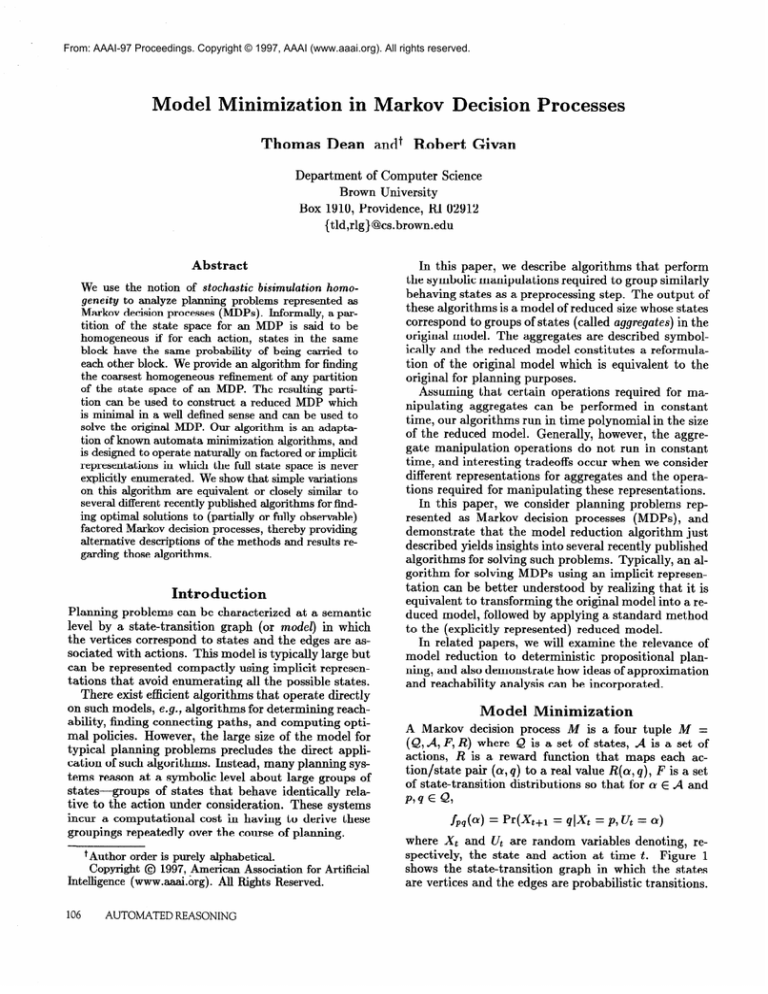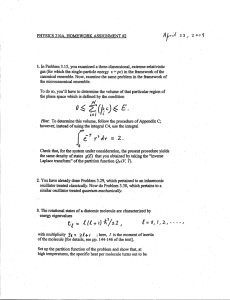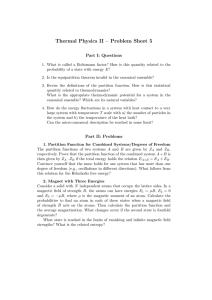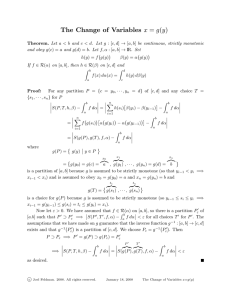
From: AAAI-97 Proceedings. Copyright © 1997, AAAI (www.aaai.org). All rights reserved.
Model Minimization
Thomas
in Markov Decision
andi
Dean
Department
Robert
of Computer
Givan
Science
Brown University
Box 1910, Providence,
RI 02912
{tld,rlg}@cs.brown.edu
Abstract
We use the notion of stochastic
bisimulation
hornogene&y to analyze planning problems represented as
Markov decision processes (MDPs). Informally, a partition of the state space for an MDP is said to be
homogeneous if for each action, states in the same
block have the same probability of being carried to
each other block. We provide an algorithm for finding
the coarsest homogeneous reflnement of any partition
of the state space of an MDP. The resulting partition can be used to construct a reduced MDP which
is minimal in a well defined sense and can be used to
solve the original MDP. Our algorithm is an adaptation of known automata minimization algorithms, and
is designed to operate naturally on factored or implicit
representations in which the full state space is never
explicitly enumerated. We show that simple variations
on this algorithm are equivalent or closely similar to
several different recently published algorithms for fmding optimal solutions to (partially or fully observable)
factored Markov decision processes, thereby providing
alternative descriptions of the methods and results regarding those algorithms.
Introduction
Planning problems can be characterized at a semantic
level by a state-transition
graph (or modet) in which
the vertices correspond to states and the edges are associated with actions. This model is typically large but
can be represented compactly using implicit representations that avoid enumerating all the possible states.
There exist efficient algorithms that operate directly
on such models, e.g., algorithms for determining reachability, finding connecting paths, and computing optimal policies. However, the large size of the model for
typical planning problems precludes the direct application of such algorithms. Instead, many planning systems reason at a symbolic level about large groups of
states-groups
of states that behave identically relative to the action under consideration.
These systems
incur a computational
cost in having to derive these
groupings repeatedly over the course of planning.
tAuthor order is purely alphabetical.
Copyright @ 1997, American Association for Artificial
Intelligence (wwwaaaiorg).
106
AUTOMATED
All Rights Reserved.
REASONING
In this paper, we describe algorithms that perform
the symbolic manipulations required to group similarly
behaving states as a preprocessing step. The output of
these algorithms is a model of reduced size whose states
correspond to groups of states (called aggregates) in the
original model. The aggregates are described symbolically and the reduced model constitutes a reformulation of the original model which is equivalent to the
original for planning purposes.
Assuming that certain operations required for manipulating aggregates can be performed in constant
time, our algorithms run in time polynomial in the size
of the reduced model. Generally, however, the aggregate manipulation
operations do not run in constant
time, and interesting tradeoffs occur when we consider
different representations for aggregates and the operations required for manipulating these representations.
In this paper, we consider planning problems represented as Markov decision processes (MDPs),
and
demonstrate that the model reduction algorithm just
described yields insights into several recently published
algorithms for solving such problems. Typically, an algorithm for solving MDPs using an implicit representation can be better understood by realizing that it is
equivalent to transforming the original model into a reduced model, followed by applying a standard method
to the (explicitly represented) reduced model.
In related papers, we will examine the relevance of
model reduction to deterministic
propositional
planning , and also demonstrate how ideas of approximation
and reachability analysis can be incorporated.
Model
Minimization
A Markov decision process M is a four tuple M =
(Q, CA,F, R) where & is a set of states, d is a set of
actions, R is a reward function that maps each action/state pair (o, q) to a real value R(cr, a), F is a set
of state-transition
distributions so that for cy E d and
P,fIl E Q,
&JQ)
= P&G+1
= qlxt
= P, ut
= Q)
where Xt and Vc are random variables denoting, respectively, the state and action at time t. Figure 1
shows the state-transition
graph in which the states
are vertices and the edges are probabilistic transitions.
Figure 1: State-transition graph for the MDP in which
Q = {1,2,3,4},
d = {a,b},R(-,
1) = R(., 4) = 1,
R(., 2) = R(., 3) = 0, and the transition probabilities
are indicated in parentheses.
In this paper, we refer to the state-transition
graph
as a model for the underlying dynamics of a planning
problem (Boutilier, Dean, & Mar&s 1995).
A policy is a mapping from states to actions, n :
& +- d. The v&e function for a given policy maps
states to their expected value given that you start in
that state and act according the given policy:
QEQ
where y is the discozlnt rate, 0 5 y < 1, and we assume
for simplicity that the objective function is expected
discounted cumulative reward (Puterman 1994).
Bn} be a partition of Q. P has the
Let P= {Br,...,
property of stochastic bisimulation
homogeneity
with
respect to M if and only if for each Bi, Bj E P, for
each o E d, for each p, q E Bi,
c
fPr(4 =
c
fqr(4
rEB,
rEBj
For conciseness, we say P is homogeneous.’
A homogeneous partition is a partition for which every block
is stable (see Definition 1).
The model with aggregate states corresponding
to
the blocks of B and transition probabilities defined by
f&(4 =
):
fpr(4
rEBj
where p is any state in Bi is called the quotient model
with respect to P.
A partition P’ is a refinement of a partition P if and
only if each block of P’ is a subset of some block of P;
in this case, we say that P is coarser than P’. The
term splitting refers to the process whereby a block of
a partition is divided into two or more sub-blocks to
obtain a refinement of the original partition.
We introduce the notion of an initial partition
to
encode certain basic distinctions among states. In traditional AI planning, we might use an ‘initial partition
’ Stochastic bisimulation homogeneity is closely related
to the substitution
property for finite automata developed
by Hartmanis and Stearns (1966) and the notion of Zumpab&y for Markov chains (Kemeny & Snell 1960).
consisting of two blocks of states: those that satisfy the
goal and those that do not. In solving an MDP, we distinguish states that differ on the basis of reward. Given
the distinctions implied by an initial partition, other
distinctions follow as a consequence of the dynamics.
In particular, a homogeneous refinement of the initial
partition is one that preserves the initial distinctions
and aggregates blocks that behave the same. For any
particular initial partition, there is one homogeneous
refinement that is of particular interest.
P, there esis ts a
refinement OfP.
TBneorern 1 For any initial partition
unique coarsest homogeneous
The existence of this refinement of P follows by analyzing the algorithm described below.
In the remainder of this section, we consider an
algorithm2 called the model minimization
algorithm
(or simply the minimization
azgorithm) which starts
with an initial partition PO and iteratively refines that
partition by splitting blocks until it obtains the coarsest homogeneous
refinement of PO. We refer to this
refinement as the target partition.
We discuss the algorithm at an abstract level, leaving the underlying
representation
of the partitions
unspecified-hence
our complexity
measures are in
terms of the number of partition manipulation
operations, and the actual complexity depends on the underlying partition representation and manipulation algorithms. Our complexity measures are relative to the
number of blocks in the resulting partition.
Definition P We say that a block C of a partition P
is stable with respect to a block B of P and action CY
if and only if every state in C has the same probability
of being carried into block B by action cr. Formally,
3c E [0, 11,Vp E C, Pr(Xt+l
E BIXt = p, Ut = a) = c
where
Pr(Xt+r
E BlXt
C Pr(Xt+l
qEB
= p, tYt = a) =
= qlXt =p,ut
= cy)
We say that C is stable if C is stable with respect to
every block of P and action in d.
A partition is homogeneous exactly when every block
is stable. The following theorem implies that any unstable block in the initial partition can be split immediately, with the resulting new partition retaining the
property that it can be refined into the target partition. By repeatedly finding unstable blocks and splitting them, we can thus find the target partition in linearly many splits in the target partition size (each split
increases the partition size, which cannot exceed that
of the target partition).
2Our algorithm is an adaptation of an algorithm by Lee
and Yannakakis (1992) which is related to an algorithm by
Bouajjani et al. (1992).
MODELING FOR DECISION PROCESSES
107
Theorem 2 Given a partition P, blocks B and C of
P, and states p and q in block C such that
Pr(Xt+lEqXt
=p)#
P+G+1E
qxt
=a>
then p and q do not fall in the same block of the coarsest
homogeneous
refinement of P.
This theorem yields an algorithm for finding the
target partition in linearly many split operations and
quadratically
many stability checks:3
simply check
each pair of blocks for stability, splitting each unstable
block as it is discovered.
Specifically, when a block C
is found to be unstable with respect to a block B and
action cy, we replace C in the partition by the uniquely
determined sub-blocks
C;L, . . . , ck such that each Ci
is a maximal sub-block of C that is stable with respect to B and Q. We denote the resulting partition
by SPLIT&C,
P, cy) , w h ere P is the partition just before splitting C.
Theorem 3 Given any initial partition P, the model
minimization
algorithm computes the coarsest homogeneous refinement of P.
The immediate reward partition is the partition in
which two states, p and q, are in the same block if and
only if they have the same rewards, Vo E A, R( o, p) =
R(a, q). Let P* be the coarsest refinement of the initial
reward partition.
The resulting quotient model can
be extended to define a reduced MDP by defining the
reward R’(a, i) for any block BI and action a to be
R(a,p)
for any state p in Bi.
Theorem 4 The exact solution of the reduced
induces an exact solution of the original MDP.
MDP
The above algorithm is given independent
of the
choice of underlying representation of the state space
and its partitions.
However, we note that, in order
for the algorithm to guarantee finding the target partition we must have a sufllciently expressive partition
representation such that any arbitrary partition of the
state space can be represented.
Typically, such partition representations
may be expensive to manipulate, and may blow up in size. For this reason, we
also consider partition manipulation
operations that
do not exactly implement the splitting operation described above. Such operations can still be adequate
for our purposes if they differ from the operation above
in a principled manner: specifically, if whenever a split
is requested, the operation splits “at least as much”
as requested.
Formally, we say that a block splitting
operation SPLIT’ is adequate if SPLIT’(B, C, B, cu) is
always a refinement of SPLIT(B, C, P, a), and we refer to the minimization algorithm with SPLIT replaced
30bserve that the stability of a block C with respect to
another block B and any action is not affected by splitting
blocks other than B and C, so no pair of blocks need ever be
checked twice. Also the number of blocks ever considered
cannot exceed twice the number of blocks in the target
partition (which bounds the number of splits performed).
108
AUTOMATED
REASONING
by SPLIT’ as adequate minimization.
We refer to adequate splitting operations which properly refine SPLIT
as non-optimal.
Note that such operations may be
cheaper to implement than SPLIT even though they
“‘split more” than SPLIT.
Theorem 5 The minimization
algorithm with SPLIT
replaced by any adequate SPLIT’ returns a refinement
of the target partition, and the solutions of the resulting
reduced MDP still induce optimal solutions.
Many published techniques that operate on implicit
representations closely resemble minimization with adequate but non-optimal
splitting operations.
We describe some of these techniques and the connection to
minimization
later in this paper. In the next section,
we introduce one particular method of implicit representation which is well suited to MDPs and then use
this as a basis for our discussion.
Fact ore
presentations
In the
remainder
o
is paper, we make use of
Bayesian networks (Pearl 1988) to encode implicit (or
factored) representations; however, our methods apply
to other factored representations
such as probabilistic STRIPS operators (Kushmerick,
Hanks, & Weld
1995).
Let X = {Xl,. . . , Xna} represent the set of
state variables. We assume the variables are boolean,
and refer to them also as fluepats. The state at time t
is now represented as a vector Xt = (Xl,t , . . . , Xm,t)
where XQ denotes the ith state variable at time t. A
two-stage temporal Bayesian network (2TBN) (Dean &
Kanazawa 1989) is a directed acyclic graph consisting
of two sets of variables {Xi,g} and {Xi,t+r}
in which
directed arcs indicating dependence are allowed from
the variables in the first set to variables in the second set and between variables in the second set. The
state-transition
probabilities are now factored as
Pr(Xt+l
IXt, &) =
Pr(Xi,t+llParents(Xd,t+l)l
ut)
i=l
where Parents(X)
denotes the parents of X in the
2TBN and each of the conditional
probability distributions Pr(X++r IParents(Xi,t+l),
Ut) can be represented as a conditional probability table or as a decision tree which we do in this paper following (Boutilier,
Dearden, & Goldszmidt 1995). We enhance the 2TBN
representation
to include actions and reward functions; the resulting graph is called an influence diagram (Howard & Matheson 1984).
Figure 2 illustrates a factored representation
with
three state variables, X = (A, B, C}, and describes
the transition probabilities and rewards for one action.
The factored form of the transition probabilities is
Pr(Xt+l
IXt, &) =
Pr(-&+&%,
Bt) Pr(Bt+l
I&) Pr(Ct+l
where in this case Xt = (At, Bt , Ct).
ICt, Bt)
represented in DNF as the full set of complete truth
assignments to S. Note that this representation cannot
express most partitions.
Existing
Figure 2: A factored representation
variables: A, B and C.
with three state
AaD4A
(4
W
Figure 3: Quotient models for the MDP represented by
the factored representation shown in Figure 2 for (a)
the immediate reward partition and 64 the coarsest
homogeneous partition computed by the minimization
algorithm.
Figure 3(a) shows the quotient model induced by the
immediate reward partition for the MDP described in
Figure 2; there are two blocks: states in which the
reward is 1 and states in which the reward is 0. Figure 3(b) shows the quotient model for the refined partition constructed by the model minimization algorithm.
In this paper, we consider two different partition representations. The first and most general representation
we use represents a partition as a set of mutually inconsistent DNF boolean formulas, one for each block, such
that a state is in a block if and only if the state’s corresponding truth assignment satisfies the block’s DNF
formula.
Given the generality of this representation,
the following result is not surprising.
Theorem
6 Given a factored MDP and initial partition P represented
in DNF, the problem of finding
the coarsest homogeneous
refinement of P is NP-hard,
even under the assumption that this rejinement has a
DNF representation
of size polynomial in 1x1.
The NP-hardness in the above theorem lies in maintaining DNF block descriptions in simplest form. The
minimization
algorithm described above can run in
time polynomial
in the size of its output if it never
simplifies the block descriptions-however
that output
will therefore not be the simplest description of the
coarsest homogeneous refinement of P.
As a second partition representation,
we consider
any subset S of the fluents (i.e., X) to be the fluentwise representation of the partition which would be
Algorithms on Factored
epresentations
In the following three subsections, we briefly describe
several existing algorithms that operate on factored
We argue that each algorithm
is
representations.
asymptotically
equivalent to first applying the minimization algorithm and then solving it using an algorithm that operates on the reduced MDP. Space limitations preclude detailed descriptions of the algorithms
and explication of the background necessary to formalize our arguments; hence, the arguments provided in
this paper are only sketches of the formal arguments
provided in the longer version of this paper.
State-Space Abstraction
State-space abstraction (Boutilier & Dearden 1994) is
a means of solving a factored MDP by generating an
equivalent reduced MDP by determining with a superficial analysis which fluents’ values are necessarily
DP generirrelevant to the solution.
The reduced
ated is always a fluentwise partition of the state space,
and the analysis can be viewed as minimization where
the splitting operation is adequate but non-optimal.
Let FSPLIT(B,
6, P, CY) be the coarsest refinement
of SPLIT(B, C, P, o) which is fluentwise representable.
FSPLIT is adequate and computable in time polynomial in the size of M.
Theorem
7 Minimization
using FSPLIT
yields
same partition that state space abstraction does.
the
The following theorem shows that there is an optimal reduced MDP given the restriction to fluentwise
partitions.
Theorem
8 FOT any MDP and initial partition
there is a unique coarsest homogeneous
refinement
P that is fluentwise representable.
P,
of
The state-space abstraction analysis is quite sensitive to the factored representation of the MDP. A particular explicit MDP may have many difIerent factored
representations,
and state space abstraction performs
well only when the representation
chosen represents
the independence properties of the fluents well, so that
the superficial analysis can easily detect which fluents
are relevant. The presentation in (Boutilier & Dearden
1994) relies on a slightly more expressive factored rep
resentation than that presented above to allow the expression of a richer class of independence propertieseach action is described by multiple but consistent aspects which apply simultaneously;
each aspect is represented just as an action above. The next theorem
shows that, using this more expressive representation,
there is always a way to factor an explicit MDP so that
the optimal fluentwise partition is found by state-space
abstraction and/or FSPLIT minimization.
MODELING FOR DECISION PROCESSES
109
Theorem
9 For any MDP M and initial partition P,
there is a factored MDP representation of M (using aspects) such that state space abstraction finds the coarsest homogeneous fluentwise refinement of P.
Structured
Policy
Iteration
is a well-known technique for finding
an optimal policy for an explicitly represented MDP
by evaluating the value at each state of a fixed policy and using those values to compute a locally better
policy-iterating
this process converges to an optimum
policy (Puterman 1994). In explicit MDPs, the evaluation of each fixed policy can be done with another
well-known algorithm called successke approsimata’on,
which involves repeatedly computing the value of each
state using the just computed values for neighboring
states-iterating
this process converges in the infinite
limit to the true values, and a stopping criterion can
be designed to indicate when the estimated values are
good enough to proceed with another step of policy
iteration (Puterman 1994).
Boutilier et al. (1995) describe variants of policy iteration and successive approximation
designed to work
on factored MDP representations,
called structured
pola’cy iteration (SPI) and structured successive approzimata’on (SSA), respectively.
These algorithms can
both be understood as variants of minimization using
a particular non-optimal but adequate split operation.
For the remainder of this paper, we assume the DNF
partition representation.
Policy
iteration
Definition 2 We say that a block C of a partition P
is fluentwise stable with respect to a fluent Xk and ac-
tion Q if and only if every state in C has the same
probabdity under action c~!of being carra’ed into a state
with Xk true. Formally,
3c E [o, 11, vp E C,
Pr(xk,t+lIXt
= p, ut
=
a)
=
C
We say that C is fluentwke stable with respect to block
B and action ~11if C is fluentwise stable with respect to
every fluent menta’oned in the DNF formula describing
block B.
Let SSPLIT(B, C, P, CY)be the coarsest refinement of
SPLIT(B, C, P, cy) f or which C is fluentwise stable with
respect to B and a. SSPLIT is adequate and computable in time polynomial
in the number of new
blocks introduced plus the size of its inputs.
For a fixStructured Successive Approximation
ed policy r and MDP M, we define the n-restricted
MDP MT to be the MDP M modified so that actions
not prescribed by 7r do nothing: in MT, if action a is
taken in a state Q such that o # n(a), the result is
state Q again with probability
1. Minimization
of the
n-restricted MDP using SSPLIT is equivalent to SSA.
Theorem
10 For any MDP M and policy IT, SSA applied to M and K produces the same resulting partition and value convergence properties as minimization
110
AUTOMATED
REASONING
of M, using SSPLIT, followed by traditional successive approzimataon on the resulting reduced MDP. Both
algorithms run in time polynomial in the number of
blocks in the resulting partition.
Each iteration of
Structured
P&icy Iteration
structured policy iteration accepts as input a value
function VT : & + 72, and selects a new policy X’
by considering the possible advantages of choosing actions on the first step alternative to those indicated
by the current policy and assuming that the value in
subsequent steps is determined by V,. We cast policy iteration as a minimization problem by considering
a special MDP MPl (where PI stands for “policy improvement”)
that forces all actions after the first step
to be chosen according to ?r. In order to distinguish the
first step from subsequent steps, we introduce a new
fluent First. The actions executed on the first step are
executed in the subspace in which First is true and actions executed on subsequent steps are executed in the
subspace in which First is false. For a factored MDP
M with fluents X and policy X, we define MPl to be
the MDP with fluents X U {First} so that
o the actions always set First to false,
m when First is true, the actions behave on X as they
would in M, and
o when First is false, the actions behave on X as they
would in MT.
Thessena
11 For any MDP M and previous policy R,
one iteration of SPI computes the same partition as the
partition of the subspace in which First is true which is
produced by the minimization
of MPI using SSPLIT.
Once the new partition
is computed
(by either
method),
we select an improved policy by choosing
for each block of the new partition the action that
maximizes the immediate reward plus the probability
weighted sum of the V, values of the possible next
states.
Explanation-Based
Learning
einforcernent
Splitting an unstable block requires computing
the
preimage of the block with respect to an action. This
basic operation is also fundamental in regression planExplanationning and explanation-based
learning.
based learning (EBL) techniques use regression to manipulate sets instead of individual states.
Reinforcement
learning (RL) is an on-line method
for solving MDPs (Rarto, Sutton, & Watkins 1990),
essentially by incremental, on-line dynamic programming. Dietterich and Flann (1995) note that computing preimages is closely related to the iterative (dynamic programming)
step in policy iteration and other
standard algorithms for computing
optimal policies.
They describe RL algorithms that use regression in
combination
with standard RL and MDP algorithms
to avoid enumerating individual states
Their algorithms make use of a particular representation for partitions based on rectangular regions of
the state space. The direct application of model minimization in this case is complicated due to the on-line
character of RL. However, an off-line variant (which
they present) of their algorithm can be shown to be
asymptotically equivalent to first computing a reduced
model using an adequate splitting operation based on
their rectangular partition representation followed by
the application of a standard RL or MDP algorithm to
the reduced model. We suspect that the rest of their
algorithms as well as other RL and MDP algorithms for
handling multidimensional state spaces (Moore 1993;
Tsitsiklis & Van Roy 1996) can be profitably analyzed
in terms of model reduction.
Partially
Observable
MDPs
The simplest way of using model reduction techniques
to solve partially observable MDPs (POMDPs) is to
apply the model minimization algorithm to an initial
partition that distinguishes on the basis of both reward
and observation and then apply a standard POMDP
algorithm to the resulting reduced model. We suspect
that some existing POMDP algorithms can be partially understood in such terms. In particular, we conjecture that the factored POMDP algorithm described
in (Boutilier & Poole 1996) is asymptotically equivalent to minimiz’ mg the underlying MDP and then using
Monahan’s (1982) POMDP algorithm.
Conclusion
This paper is primarily concerned with introducing the
method of model minimization for MDPs and presenting it as a way of analyzing and understanding existing algorithms. We are also working on approximation algorithms with provable error bounds that construct reduced models using a criterion for approximate stochastic bisimulation homogeneity.
The methods of this paper extend directly to account for reachability from an initial state or set of
initial states. We are also working on algorithms that
use minimization and reachability to extend decomposition and envelope-based techniques such as (Dean et
al. 1995) to handle factored representations.
Boutilier, C., and Dearden, R. 1994. Using abstractions
for decision theoretic planning with time constraints. In
Proceedings
AAAI-94,
AAAI.
1016-1022.
Boutilier, C., and Poole, D. 1996. Computing optimal
policies for partially observable decision processes using
compact representations. In Proceedings AAAI-96,
11691175. AAAI.
Boutilier, C.; Dean, T.; and Hanks, S. 1995. Planning
Structural assumptions and compuunder uncertainty:
t ational leverage. In Proceedings of the Third European
Workshop
on Pianndng.
Boutilier, C.; Dearden, R.; and Goldszmidt, M.
1995.
Exploiting structure in policy construction. In Proceedings
IJCAI 14, 1104-1111. IJCAII.
Dean, T., and Kanazawa, K. 1989. A model for reasoning
about persistence and causation. Computational
Intedli-
gence 5(3):142-150.
Dean, T.; KaelbIing, L.; Kirman, J.; and Nicholson, A.
1995. Plannin g under time constraints in stochastic domains. Art$ca’al Intelligence 76( l-2):35-74.
Dietterich, T. G., and Flann, N. S. 1995. Explanationbased learning and reinforcement learning: A unified view.
In Proceedings Twelfth International
Conference on Machs’ne Learning, 176-184.
Hartmanis, J., and Stearns, R. E. 1966. Algebraic
ture Theory of Sequential Machines.
Englewood
N.J.: Prentice-Hall.
StrucCIiffs,
Howard, R. A., and Matheson, J. E. 1984. Influence diagrams. In Howard, R. A., and Matheson, J. E., eds., The
Principles and Applications
of Decision Analysis. Menlo
Park, CA 94025: Strategic Decisions Group.
Kemeny,
J. G.,
and Snell, J. L.
1960.
Finite
Markov
Chains. New York: D. Van Nostrand.
Ku&me&k,
N.; Hanks, S.; and Weld, D. 1995. An algorithm for probabilistic pl arming. Artificial Intelligence
76( l-2).
Lee, D., and Yannakakis, M. 1992. Online minimization
of transition systems. In Proceedings of %$th Annual ACM
Symposipsm on the Theory of Computing.
Monahan, G. E. 1982. A survey of partially observable
Markov decision processes: Theory, models, and algorithms. Management
Science 28( l):l-16.
Moore, A. W. 1993. The pa&i-game algorithm for variable resolution reinforcement learning in multidimensional
state spaces. In Hanson, S. J.; Cowan, J. D.; and Giles,
C. L., eds., Advances in Neural Information Processing 5.
San Francisco, California: Morgan Kaufmann.
Pearl, J. 1988. Probabilistic
tems: Networks
Reasoning in Intelligent Sysof Plausible Inference. San Francisco, Cal-
ifornia: Morgan Kaufmaun.
References
Barto, A. G.; Sutton, R. S.; and Watkins, C. J. C. H. 1990.
Learning and sequential decision making. In Gabriel, M.,
and Moore, J., eds., Learning and Computational
Neuroscience: Foundations of Adaptive Networks. Cambridge,
Massachusetts: MIT Press.
Puterman, M. L. 1994. Markov
York: John Wiley & Sons.
Decision
Processes.
New
Tsitsiklis, J. N., and Van Roy, B. 1996. Feature-based
methods for large scale dynamic programming. Machine
Learning 22:59-94.
Bouajjani, A.; Fernandez, J.-C.; Halbwachs, N.; Raymond, P.; and Ratel, C. 1992. Minimal state graph generation. Scs’ence of Computer Programming 18:247-269.
MODELING FOR DECISION PROCESSES
111






